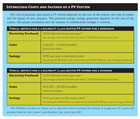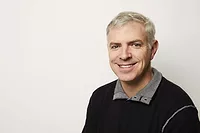Solar Energy: A Golden Opportunity
As the concern over fossil fuels reaches a fever pitch in the American consciousness, a number of solutions are being offered to save energy, save money and save the world. Products like cool roofing and superior insulation have penetrated the market enough to leave room for more innovations, and solar continues to get more attention with every sunrise.

Is it the golden age for solar energy? New Jersey’s Clean Energy Program is currently oversubscribed, meaning more people want the financial incentives than there are funds available. Florida has already burned through two-thirds of its $2.5 million worth of solar incentives in a program’s first year, as the legislature debates increasing more funding for the sunshine state. Companies in California, New York, Colorado and other states are installing their solar panels on buildings they don’t own, selling the electricity to the occupants and making money for their investors, using energy that is tax-free, pollution-free, conflict-free and just plain free.
Can solar energy really save the day?
As the concern over fossil fuels reaches a fever pitch in the American consciousness, a number of solutions are being offered to save energy, save money and save the world. Products like cool roofing and superior insulation have penetrated the market enough to leave room for more innovations, and solar continues to get more attention with every sunrise. While there are challenges ahead, the one element that is most responsible for aging roofs is being deployed to make money for roofing contractors and their clients.
“I think there is a pent-up demand for people who want to make a difference,” says Paul Norton, senior engineer with the National Renewable Energy Laboratory in Golden, Colo.
“Certainly it can be done in any part of the country. The economics vary from climate to climate and utility to utility.”

“It’s the right thing to do, though not necessarily cheap,” says Boon, who was an instructor at the Roofing Industry Educational Institute and an engineer at Firestone Building Products. “It’s amazing how may of these units are going on the houses of just regular people. It’s your next-door neighbor.”
Thanks to legislation that mandates a percentage of new power generation come from renewable resources, Xcel Energy, a provider to eight states, offers up to $4.50 per watt rebates for those who install photovoltaic (PV) arrays that generate electricity from sunlight. Denver is an excellent climate for solar, and those with the resources and inclination to make the investment hope it will pay off in 10 to 15 years.
“This is just the next logical step,” says Boon. “We have more sunny days than San Diego.”
Boon expects the PV cells to generate electricity for at least 20 years; many manufacturers guarantee the electrical output of their systems. He sees a role in all this for the roofing industry, but still hasn’t seen a convincing pairing of electricity and waterproofing. It will ultimately be up to the consumer to decide whether to attach his expensive investment onto a reliable roof or make them portable enough to remove roofing from the equation. One could even argue that the panels themselves offer a measure of protection for the roof areas they cover. For the “early adopters” that Boon sees every week, aesthetics are in the eyes of the homeowner.
“My opinion as an engineer? It looks like money,” he says. “This is a response to the importation of oil. It’s a way to respond to the oil funds that end up in the hands of terrorists.”

The effort is part of thousands of projects through the Building America program, a public private partnership that could alter the way Americans build and live in their homes. One of the goals is to create a zero-energy home that is sustainable, affordable and practical. Although it takes a considerable investment to make a zero energy home, Norton thinks that the broad use of solar power to generate electricity is a wise financial strategy. “You can think of it as a hedging strategy where you’ve got flat energy costs for up to 20 years,” he says. “This is a way to guarantee yourself a level utility bill for the long term.”
Wind is a highly feasible technology for parts of the country, yet the aesthetics and maintenance are too much for residents to consider. Geothermal systems usually require a new installation. But the roof gets the most sun, it’s out of the way, and roofs make up millions of acres of unused real estate that can be deployed for a greater purpose. In an age where schools are installing PV cells and subdivisions in California are orienting the roof slopes to face south for maximum solar benefit, the sky is the limit. Even the fussiest homeowners’ associations that are concerned about appearance can see the light.
“The way that we’re doing solar homes now, you could walk right down the street and not notice that this house is producing as much energy as it’s consuming,” says Norton.

States like California, New Jersey and Florida offer rebates for installations that generate energy from renewable sources, and solar fits the bill for much of the country. Cold climates that aren’t associated with abundant sun - such as New Jersey and Oklahoma - are feasible environments for PV installations offering predictable returns. Erik Lensch gave up a career in financial services when he realized the returns that solar energy can provide for investors.
“My background lends itself well to doing that analysis,” says the president of SC Solar, an eight-year-old solar contracting firm he bought last year. “There are a number of different calculations used in looking at the equipment as well as payback.”
Lensch’s father was into renewable energy in the early 1980s, installing solar water heaters and wood stoves in Roanoke, Va. The elimination of federal tax credits in 1986 dried up most of the customers, until the perfect storm of rising prices, pollution and energy availability compelled Americans to reconsider their energy costs and the ramification of their purchase decisions on the planet.
That kind of inclination is valuable, says Lensch, as he guides potential customers through the equations that can spell out energy savings, less pollution and a real financial payoff down the road.
“I think you have to have a desire to make a difference right now,” he says. “It’s much more than the financial impact. It’s the PR that it generates. And there’s more corporate responsibility today.”
One recent project by SC Solar was commissioned by Half Moon Outfitters, a regional chain in New England that is getting a lot of publicity for its installation of a 4.2 kW system installed on its distribution center in North Charleston, S.C. On big commercial projects, Lensch is glad to leave the installation and waterproofing of roof mounts to a qualified roofing contractor. This often leads to a conversation with the building owner about longevity and making sure the roofing system is up for the long haul. “If it has to be replaced within the next 10 years, we certainly advise them to do it,” says Lensch.
While that adds to the cost, having a robust roofing system with low life-cycle costs that is essentially protected by large panels is not exactly taking it on the chin. With information about tax credits and incentives that pay over half the cost of a PV system, Lensch shows customers how quickly they can get a return on investment. For instance, North Carolina offers a 35 percent tax credit that, combined with the 30 percent federal tax credit, allows for an average ROI of 6.5 years, according to the SC Solar’s Web site (www.scsolar.com). There is a $2,000 cap for homeowners on the federal tax credit, but there is no cap for businesses, meaning companies with large roofs that need replacing might use solar energy as a revenue stream to service the debt.
The ability to sell excess electricity back to utility companies is a significant factor in the payoff period. Only nine states do not mandate “net metering” from utilities, according to Lensch, and often will charge customers retail rates but pay wholesale for any electrical contribution to the grid. While most residential customers enjoy basic rates throughout the day, large consumers of electricity like manufacturers and schools must pay peak rates when demand on the grid creates huge spikes in prices. Utilities will charge several dollars per kWh for a few hours each day, representing as much as half the energy bill for some customers.
In the Sunbelt and other areas of the country, this peak demand often occurs when the sun is at is hottest and solar energy works the hardest. California utilities are encouraging the use of solar to add electrical capacity when they need it most, without operational costs, pollution or noise.
“Net metering is where everything kind of starts,” says Lensch. “If you start to factor in what the difference is for peak rates, solar definitely has a big impact.”
Another factor to consider is the type of PV system to install. PV silicon modules are the prefabricated panels that mount onto the roof using supports and have efficiencies of 15 to 20 percent (conversion rate of sunlight to electricity). Amorphous film is a newer development that is cheaper to make and can be adhered directly to roofing systems, but it’s efficiency is about 8 percent. However, Lensch has observed that since silicon cells lose their efficiency the hotter they get and the films do not, he’s seeing a rate difference of a few percentage points during the hottest times of the day. Despite all the numbers and calculations, sometimes the sale boils down to aesthetics and the decision to use solar energy might just be a matter of taste.
“We lose sales all the time because the husband wants it but the wife doesn’t like the way it looks,” he says.

While Habitat for Humanity strives to make its houses uniform, the Lee County chapter accepted the donation to help a deserving family make their home even more affordable. Energy conservation is a priority for the organization, which strives to ensure that its houses have proper insulation and helps new owners set a realistic budget. A large portion of the eight-hour homeowner program that Habitat requires before occupying a house is dedicated to a class taught by Lee County Electric Co-op.
“It teaches our clients how to save energy,” says Becky Sanders, executive director for Habitat for Humanity of Lee County. “We want to make sure that when they get into their house, we’re setting them up for success.”
“Regardless of income, any household with kids can benefit from solar water heating. Since no one expects the price of energy to come down, the returns on solar will only improve over time,” says Brian Goldberg, co-owner of Advance Solar. “This is simply the best investment homeowners can make right now, and we’re urging people to take advantage of incentives that begin to expire next year.”
The Energy Policy Act of 2005 offers a 30 percent federal tax credit for purchasers of solar appliances. The 2006 Florida Energy Act offers $500 rebates to those same customers in Florida. Rebates for commercial operations are even larger.

Is it the golden age for solar energy? New Jersey’s Clean Energy Program is currently oversubscribed, meaning more people want the financial incentives than there are funds available. Florida has already burned through two-thirds of its $2.5 million worth of solar incentives in a program’s first year, as the legislature debates increasing more funding for the sunshine state. Companies in California, New York, Colorado and other states are installing their solar panels on buildings they don’t own, selling the electricity to the occupants and making money for their investors, using energy that is tax-free, pollution-free, conflict-free and just plain free.
Can solar energy really save the day?
As the concern over fossil fuels reaches a fever pitch in the American consciousness, a number of solutions are being offered to save energy, save money and save the world. Products like cool roofing and superior insulation have penetrated the market enough to leave room for more innovations, and solar continues to get more attention with every sunrise. While there are challenges ahead, the one element that is most responsible for aging roofs is being deployed to make money for roofing contractors and their clients.
“I think there is a pent-up demand for people who want to make a difference,” says Paul Norton, senior engineer with the National Renewable Energy Laboratory in Golden, Colo.
“Certainly it can be done in any part of the country. The economics vary from climate to climate and utility to utility.”

The Munich airport sports a solar array. (Photo courtesy of BP.)
Putting it Where the Sun Shines
In early 2006, Rich Boon, PE, began getting calls from homeowners and business owners who needed an engineer to assess their perfectly good roofs. From out of nowhere, the Denver roof consultant was making sure that roofs could handle the extra weight of solar arrays that people were installing. He averages about two projects a week and is even considering installing a system on his house to take advantage of utility rebates and a 30 percent federal tax credit.“It’s the right thing to do, though not necessarily cheap,” says Boon, who was an instructor at the Roofing Industry Educational Institute and an engineer at Firestone Building Products. “It’s amazing how may of these units are going on the houses of just regular people. It’s your next-door neighbor.”
Thanks to legislation that mandates a percentage of new power generation come from renewable resources, Xcel Energy, a provider to eight states, offers up to $4.50 per watt rebates for those who install photovoltaic (PV) arrays that generate electricity from sunlight. Denver is an excellent climate for solar, and those with the resources and inclination to make the investment hope it will pay off in 10 to 15 years.
“This is just the next logical step,” says Boon. “We have more sunny days than San Diego.”
Boon expects the PV cells to generate electricity for at least 20 years; many manufacturers guarantee the electrical output of their systems. He sees a role in all this for the roofing industry, but still hasn’t seen a convincing pairing of electricity and waterproofing. It will ultimately be up to the consumer to decide whether to attach his expensive investment onto a reliable roof or make them portable enough to remove roofing from the equation. One could even argue that the panels themselves offer a measure of protection for the roof areas they cover. For the “early adopters” that Boon sees every week, aesthetics are in the eyes of the homeowner.
“My opinion as an engineer? It looks like money,” he says. “This is a response to the importation of oil. It’s a way to respond to the oil funds that end up in the hands of terrorists.”

Figure 1. Graphic courtesy of Xcel Energy. For more information on the costs and performance of solar photovoltaic systems, visit www.xcelenergy.com.
Light Up
The Denver climate is hot for renewable energy. Xcel Energy says it’s the country’s largest producer of wind energy at 1.3 Megawatts. Even Habitat for Humanity homes are benefiting from the groundswell of renewable energy opportunities. Norton of NREL oversees a zero-energy home in Denver. Within the first year of its occupation, the family of three has actually generated more electricity that it has consumed - this despite the fact that the PV arrays were covered in snow for 35 days in a row this past winter.The effort is part of thousands of projects through the Building America program, a public private partnership that could alter the way Americans build and live in their homes. One of the goals is to create a zero-energy home that is sustainable, affordable and practical. Although it takes a considerable investment to make a zero energy home, Norton thinks that the broad use of solar power to generate electricity is a wise financial strategy. “You can think of it as a hedging strategy where you’ve got flat energy costs for up to 20 years,” he says. “This is a way to guarantee yourself a level utility bill for the long term.”
Wind is a highly feasible technology for parts of the country, yet the aesthetics and maintenance are too much for residents to consider. Geothermal systems usually require a new installation. But the roof gets the most sun, it’s out of the way, and roofs make up millions of acres of unused real estate that can be deployed for a greater purpose. In an age where schools are installing PV cells and subdivisions in California are orienting the roof slopes to face south for maximum solar benefit, the sky is the limit. Even the fussiest homeowners’ associations that are concerned about appearance can see the light.
“The way that we’re doing solar homes now, you could walk right down the street and not notice that this house is producing as much energy as it’s consuming,” says Norton.

Wind turbines, like this one at an oil refinery, have proven to be feasible technology for many companies, but the issues of aesthetics and maintenance make this an unlikely choice for most homeowners or business owners. (Photo courtesy of BP.)
High Stakes
California has been a leader in solar energy production after being at the whim of energy traders in 2000 and 2001. The state is offering $2.9 billion in incentives for an effort to install one million solar roofs by 2016. This ambitious goal has inspired a bona fide frenzy for solar panels as companies tout solar energy as a financial instrument that is as predictable as, well, the sunrise.States like California, New Jersey and Florida offer rebates for installations that generate energy from renewable sources, and solar fits the bill for much of the country. Cold climates that aren’t associated with abundant sun - such as New Jersey and Oklahoma - are feasible environments for PV installations offering predictable returns. Erik Lensch gave up a career in financial services when he realized the returns that solar energy can provide for investors.
“My background lends itself well to doing that analysis,” says the president of SC Solar, an eight-year-old solar contracting firm he bought last year. “There are a number of different calculations used in looking at the equipment as well as payback.”
Lensch’s father was into renewable energy in the early 1980s, installing solar water heaters and wood stoves in Roanoke, Va. The elimination of federal tax credits in 1986 dried up most of the customers, until the perfect storm of rising prices, pollution and energy availability compelled Americans to reconsider their energy costs and the ramification of their purchase decisions on the planet.
That kind of inclination is valuable, says Lensch, as he guides potential customers through the equations that can spell out energy savings, less pollution and a real financial payoff down the road.
“I think you have to have a desire to make a difference right now,” he says. “It’s much more than the financial impact. It’s the PR that it generates. And there’s more corporate responsibility today.”
One recent project by SC Solar was commissioned by Half Moon Outfitters, a regional chain in New England that is getting a lot of publicity for its installation of a 4.2 kW system installed on its distribution center in North Charleston, S.C. On big commercial projects, Lensch is glad to leave the installation and waterproofing of roof mounts to a qualified roofing contractor. This often leads to a conversation with the building owner about longevity and making sure the roofing system is up for the long haul. “If it has to be replaced within the next 10 years, we certainly advise them to do it,” says Lensch.
While that adds to the cost, having a robust roofing system with low life-cycle costs that is essentially protected by large panels is not exactly taking it on the chin. With information about tax credits and incentives that pay over half the cost of a PV system, Lensch shows customers how quickly they can get a return on investment. For instance, North Carolina offers a 35 percent tax credit that, combined with the 30 percent federal tax credit, allows for an average ROI of 6.5 years, according to the SC Solar’s Web site (www.scsolar.com). There is a $2,000 cap for homeowners on the federal tax credit, but there is no cap for businesses, meaning companies with large roofs that need replacing might use solar energy as a revenue stream to service the debt.
The ability to sell excess electricity back to utility companies is a significant factor in the payoff period. Only nine states do not mandate “net metering” from utilities, according to Lensch, and often will charge customers retail rates but pay wholesale for any electrical contribution to the grid. While most residential customers enjoy basic rates throughout the day, large consumers of electricity like manufacturers and schools must pay peak rates when demand on the grid creates huge spikes in prices. Utilities will charge several dollars per kWh for a few hours each day, representing as much as half the energy bill for some customers.
In the Sunbelt and other areas of the country, this peak demand often occurs when the sun is at is hottest and solar energy works the hardest. California utilities are encouraging the use of solar to add electrical capacity when they need it most, without operational costs, pollution or noise.
“Net metering is where everything kind of starts,” says Lensch. “If you start to factor in what the difference is for peak rates, solar definitely has a big impact.”
Another factor to consider is the type of PV system to install. PV silicon modules are the prefabricated panels that mount onto the roof using supports and have efficiencies of 15 to 20 percent (conversion rate of sunlight to electricity). Amorphous film is a newer development that is cheaper to make and can be adhered directly to roofing systems, but it’s efficiency is about 8 percent. However, Lensch has observed that since silicon cells lose their efficiency the hotter they get and the films do not, he’s seeing a rate difference of a few percentage points during the hottest times of the day. Despite all the numbers and calculations, sometimes the sale boils down to aesthetics and the decision to use solar energy might just be a matter of taste.
“We lose sales all the time because the husband wants it but the wife doesn’t like the way it looks,” he says.

This Habitat for Humanity house in Lehigh Acres, Fla., sports a 4-foot by 10-foot solar panel that is mounted on four points to the roof trusses only inches from the roof surface.
SIDEBAR: Roofing Contractor Editor Helps Drives Energy Savings Lesson Home
The first Habitat for Humanity home in Lee County, Fla., to have a solar appliance is saving money for a local family thanks to a donation by Roofing Contractor’s editorial director, Rick Damato. As Habitat for Humanity looks for ways to reduce operating costs for its clients, the donated solar domestic water heater (DWH) will demonstrate that any family can benefit from water heated by the sun. The system was donated and installed by Advance Solar and Spa in Fort Myers.While Habitat for Humanity strives to make its houses uniform, the Lee County chapter accepted the donation to help a deserving family make their home even more affordable. Energy conservation is a priority for the organization, which strives to ensure that its houses have proper insulation and helps new owners set a realistic budget. A large portion of the eight-hour homeowner program that Habitat requires before occupying a house is dedicated to a class taught by Lee County Electric Co-op.
“It teaches our clients how to save energy,” says Becky Sanders, executive director for Habitat for Humanity of Lee County. “We want to make sure that when they get into their house, we’re setting them up for success.”
“Regardless of income, any household with kids can benefit from solar water heating. Since no one expects the price of energy to come down, the returns on solar will only improve over time,” says Brian Goldberg, co-owner of Advance Solar. “This is simply the best investment homeowners can make right now, and we’re urging people to take advantage of incentives that begin to expire next year.”
The Energy Policy Act of 2005 offers a 30 percent federal tax credit for purchasers of solar appliances. The 2006 Florida Energy Act offers $500 rebates to those same customers in Florida. Rebates for commercial operations are even larger.
Looking for a reprint of this article?
From high-res PDFs to custom plaques, order your copy today!




